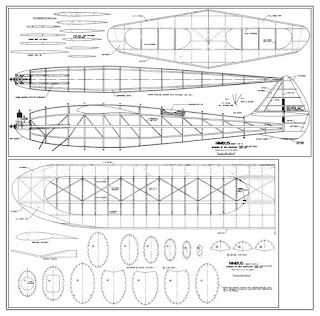I am covering a Rambler Free Flight model at this time, so I decided to use a sheet of blue and white checkerboard tissue to cover the rudder. The Rambler is covered with Polyspan. My method for applying tissue on Polyspan which has two coats of thin nitrate dope applied is as follows:
Iron the tissue to remove wrinkles.
Carefully lay the tissue on the Polyspan.
Spray with water.
Use a foam brush and carefully brush out any wrinkles.
Use the same foam brush and apply a coat of dope over the wet tissue. Some slight wrinkles can be smoothed out with your finger.
Let the tissue dry.
Apply as many coats of dope that you desire.
Covering the rudder with the checkerboard tissue I did not have to iron the tissue, it was wrinkle free. It also has a shinny side; Gene Wallock and I decided it had a sealer coat of something applied. I proceeded using steps 2 through 5. I was not too happy. There were many small wrinkles. I was afraid to try to brush the wrinkles smooth. After the tissue dried it was very difficult to see the small wrinkles. So I doped the covering a few times. It looked pretty good. I think all the squares confuse your eyesight and makes looking for wrinkles a little difficult.
I decided to talk with Gene Wallock about my covering method. Gene told me he uses acetone to attached the tissue around the edges, spray with water and let dry, then apply the dope. Gene’s method is a better method, except for using acetone to attach the tissue. I tested a scrap piece of checkerboard tissue with acetone. The acetone did not smear the shinny side of the tissue. When I lifted the tissue up off the surface, the blue was beginning to smear. So if you tried to move the tissue to reposition it was going to be very messy.
This method works.
Use a glue stick around the edges. I use an Avery Permanent Glue Stick – white color.
Carefully lay tissue on the Polyspan and press the tissue on the applied glue. You can lift the tissue up and reposition it, if required.
Spray with water.
Let dry.
Dope the tissue as required, I use a foam brush.
I should add that the checkerboard tissue from Peck Polymers was of two type: Black & Yellow and everything else.
The former appears to have started as dyed yellow tissue with black squares then dyed into it. The others look as thought they started as one color and then had shiny square painted on. Bucky has not tried the yellow & black yet.


















































